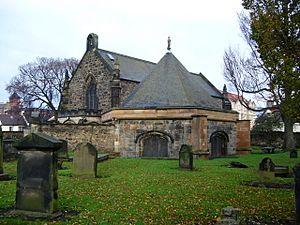Perkin Warbeck facts for kids
Quick facts for kids Perkin Warbeck |
|
|---|---|
| Pretender | |
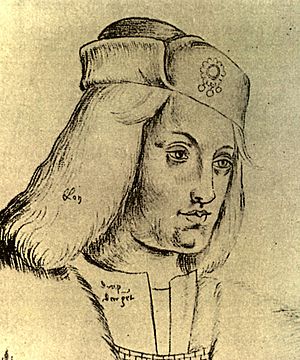
16th-century copy by Jacques Le Boucq of the only known contemporary portrait of Warbeck, Library of Arras
|
|
| Born | c. 1474 Tournai, Tournaisis |
| Died | 23 November 1499 (aged 24–25) Tyburn, Middlesex, England |
| Title(s) | Pretended Duke of York |
| Throne(s) claimed | England |
| Pretend from | 1490 |
| Connection with | Claimed to be Richard of Shrewsbury, Duke of York, son of Edward IV of England |
| Royal House | In the name of the House of York |
| Father | Jehan de Werbecque; claimed to be Edward IV of England |
| Mother | Katherine de Faro; claimed to be Elizabeth Woodville |
| Spouse | Lady Catherine Gordon |
Perkin Warbeck (born around 1474 – died 23 November 1499) was a young man who claimed to be a lost prince. He said he was Richard of Shrewsbury, Duke of York. Richard was the younger son of King Edward IV and one of the "Princes in the Tower". These princes mysteriously disappeared. If Richard had been alive, he would have been the rightful heir to the English throne.
Because no one knew for sure what happened to Prince Richard, Warbeck's claim gained some support. Some people might have truly believed him. Others simply wanted to get rid of the current king, Henry VII. Warbeck became a big problem for King Henry VII. Henry declared that Warbeck was an impostor, meaning he was pretending to be someone he wasn't.
Warbeck tried to invade England several times with small armies. But King Henry's soldiers stopped him each time. Warbeck finally surrendered in Hampshire in 1497. After he was captured, he admitted he was a Fleming from Tournai. He was executed on 23 November 1499. Dealing with Warbeck cost King Henry VII a lot of money.
Contents
Perkin Warbeck: The Boy Who Claimed to Be a Prince
Early Life and His Big Claim
Perkin Warbeck's early life story is a bit confusing. He said he was Richard of Shrewsbury, 1st Duke of York. Richard was the younger son of King Edward IV. Richard and his older brother, Edward V, disappeared after Richard, Duke of Gloucester, took the throne in 1483.
After Warbeck was caught in 1497, he confessed his real story. Many historians think this confession might not be completely true. It was made when he was under pressure. According to this confession, Warbeck was born to Katherine de Faro and John Osbeck. John Osbeck was a Flemish official in Tournai, which is now in Belgium. Records from Tournai support these family details.
When he was about ten, Warbeck went to Antwerp to learn Dutch. He worked for different masters there. Then he worked for an English merchant, trading cloth.
After his time in the Netherlands, Warbeck wanted to travel. A Breton merchant hired him. This merchant took Warbeck to Cork, Ireland, in 1491. Warbeck was about 17 years old then. He learned to speak English there.
Warbeck claimed that some people in Cork saw him dressed in fancy silk clothes. They were supporters of the House of York. They wanted to get back at the King of England. So, they decided he should pretend to be the younger son of the late King Edward IV.
How He Claimed the English Throne
Warbeck first claimed to be the Duke of York in 1490. This happened at the court of Burgundy. Special coins were even made for him there. Warbeck explained that his brother Edward V had been killed. But he, Richard, was spared because he was young and innocent. He said he had to promise not to tell his true identity for a few years.
He claimed that from 1483 to 1490, he lived in Europe. He was protected by people loyal to the York family. When his main protector went back to England, Warbeck said he was free to reveal his true identity.
In 1491, Warbeck went to Ireland. He hoped to get support there, just like Lambert Simnel had done earlier. John Atwater, a former Mayor of Cork, helped him. But not many people joined his cause. So, Warbeck had to go back to Europe.
Things got better for him there. First, Charles VIII of France welcomed him. But in 1492, Charles had to send him away. This was part of a peace deal with King Henry VII. Charles promised not to help rebels against Henry.
Warbeck was then publicly recognized as Richard of Shrewsbury by Margaret of Burgundy. She was the sister of King Edward IV. This made her the aunt of the missing princes. We don't know if Margaret truly believed Warbeck was her nephew. But she taught him how to act like a prince from the York court.
King Henry VII complained to Philip of Habsburg, the Duke of Burgundy. Henry was angry that Philip was helping Warbeck. When Philip ignored him, Henry stopped all trade with Burgundy. This hurt Burgundy's important trade with England.
Other kings also welcomed Warbeck. He was known in international talks as the Duke of York. In 1493, Emperor Maximilian I invited Warbeck to a funeral. There, Warbeck was even recognized as King Richard IV of England.
Support for Warbeck in England
Many important people in England supported Warbeck's claim. These included Lord Fitzwater, Sir Simon Montfort, Sir Thomas Thwaites, and Sir William Stanley. Sir Robert Clifford went to Europe. He wrote back to his friends, saying Warbeck was truly Prince Richard.
King Henry VII ordered these supporters to be arrested. They were all put on trial. Lord Fitzwater was sent to prison and later executed.
In January 1495, many of the people who supported Warbeck were sentenced to death. Some were pardoned later. But Sir Simon Montfort, Robert Ratcliff, and William D'Aubeney were executed. Sir William Stanley was also executed later that month. Others were imprisoned and had to pay fines. Sir Robert Clifford was pardoned and rewarded for telling the King who the conspirators were.
First Try to Land in England
On 3 July 1495, Warbeck landed at Deal in Kent. Margaret of Burgundy paid for this attempt. Warbeck hoped people would join him. But local people loyal to Henry VII fought them. Warbeck's small army was defeated. About 150 of his soldiers were killed. Warbeck didn't even get off his ship. He had to quickly retreat to Ireland.
In Ireland, he got some help from Maurice FitzGerald, 9th Earl of Desmond. They tried to attack Waterford. But they faced strong resistance. Warbeck then fled to Scotland. King Henry pardoned Warbeck's Irish supporters. He joked that they would "crown an ape next."
Support in Scotland (1495–1496)
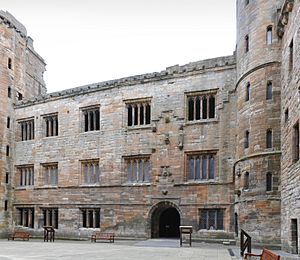
James IV of Scotland welcomed Warbeck. Warbeck stayed with the Scottish court. He was a Christmas guest at Linlithgow Palace in 1495. James knew that Warbeck's presence gave him power in international talks. Spain was trying to make an alliance with Henry VII. James knew Spain would help him to avoid war with France.
Spanish ambassadors came to Edinburgh. Later, Pedro de Ayala became a permanent ambassador during this time. Warbeck married Lady Catherine Gordon. She was the daughter of a Scottish noble. Their wedding was celebrated in Edinburgh with a tournament. James gave Warbeck special clothes and armor for the wedding.
Historians think Warbeck fought in a team with the king at the tournament. A love letter in Latin, found by Pedro de Ayala, might be Warbeck's proposal to Lady Catherine. However, it seems most people didn't truly believe Warbeck was a prince. His marriage to a Scottish noblewoman was not what you'd expect for a future King of England.
In September 1496, James IV got ready to invade England with Warbeck. A special banner was made for Warbeck as the Duke of York. James's armor was decorated, and his cannons were prepared. An English spy, John Ramsay, watched these events. He saw a Flemish knight arrive with soldiers and meet with James IV and Warbeck.
Ramsay saw many cannons and wagons for supplies. He thought the invasion force would only last a few days in England. He suggested that a small English army could defeat the Scots.
The Scottish army gathered near Edinburgh. James IV and Warbeck prayed for victory at Holyrood Abbey and at St Triduana's Chapel. On 19 September 1496, the Scottish army was at Ellem. On 21 September, they crossed the Tweed. Miners started to destroy Heaton Castle. But the army quickly left when their supplies ran out. The hoped-for support for Warbeck in Northumberland did not happen.
The Scots went about four miles into England. They destroyed a few small towers. They left on 25 September 1496 when an English army approached. When news of this invasion reached the Duke of Milan, he asked Spain to make peace between England and Scotland. The Spanish ambassador in Scotland, Pedro de Ayala, helped with this peace mission.
Later, James IV wanted to get rid of Warbeck. He gave Warbeck a ship and a crew. Horses were hired for Warbeck's companions to ride to the ship at Ayr. Pedro de Ayala went with Warbeck to Ayr. Warbeck pawned a horse for money and sailed to Waterford. James IV made peace with England by signing the Treaty of Ayton.
Warbeck tried to attack Waterford again. But this time, his effort lasted only eleven days. He was forced to flee Ireland. Four English ships chased him. Some sources say he had only about 120 men left on two ships.
Second Try to Land in England
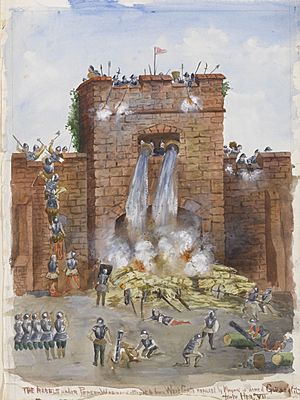
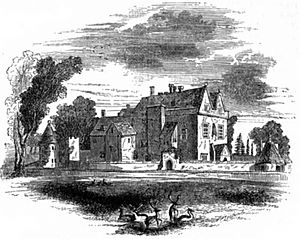
On 7 September 1497, Warbeck landed at Whitesand Bay in Cornwall. He hoped to use the Cornish people's anger. They had rebelled just three months earlier. Warbeck promised to stop unfair taxes. He was welcomed warmly. He was declared "Richard IV" on Bodmin Moor. His Cornish army, about 6,000 strong, entered Exeter. Then they moved towards Taunton.
King Henry VII sent his main general, Giles Daubeney, 1st Baron Daubeney, to fight the Cornish. When Warbeck heard that the King's scouts were nearby, he panicked. He left his army.
Warbeck was captured at Beaulieu Abbey in Hampshire. He surrendered there. Henry VII reached Taunton on 4 October 1497. He accepted the surrender of the remaining Cornish army. The leaders of the rebellion were executed. Others had to pay fines. Warbeck was imprisoned, first at Taunton, then at the Tower of London. He was paraded through the streets on horseback, with people shouting at him.
Imprisonment and Death
At first, Henry treated Warbeck well. Once Warbeck confessed he was an impostor, he was released from the Tower. He was allowed to stay at Henry's court. He even attended royal dinners. However, he was always guarded. He was not allowed to be with his wife, who was living under the queen's protection.
After eight months at court, Warbeck tried to escape. He was quickly caught again. He was then held in the Tower. He was first kept alone. Later, he was put with Edward Plantagenet, 17th Earl of Warwick. The two tried to escape together in 1499.
Caught once more, Warbeck was taken from the Tower to Tyburn, London. This happened on 23 November 1499. There, he read out a confession and was hanged. Warbeck's Irish helper, John Atwater, was also executed that day. The Earl of Warwick was executed a few days later.
Warbeck was buried in Austin Friars, London. His unmarked grave is thought to be at the Dutch Church, Austin Friars.
His story was written about in a book by Francis Bacon in 1622.
What Did He Look Like?
People said Perkin looked like King Edward IV. This made some wonder if he might have been Edward's secret son. Or perhaps he had some real connection to the York family. Francis Bacon thought he was one of Edward's many children born outside of marriage. Some also suggested he was the son of Edward's siblings, like Richard III or Margaret of York. Margaret was Warbeck's first big supporter.
Some writers, like Horace Walpole, even claimed that Warbeck really was Richard, Duke of York.
It is often said that the only picture of Perkin that still exists is a drawing from around 1570. This drawing is in a collection called the Recueil d'Arras. However, the writing on this drawing, saying it's Perkin Warbeck, is different from other notes in the collection. This drawing is placed among portraits of the Scottish and English royal family. These might be based on the work of an artist who traveled to Scotland after Perkin Warbeck left.
See also
 In Spanish: Perkin Warbeck para niños
In Spanish: Perkin Warbeck para niños


